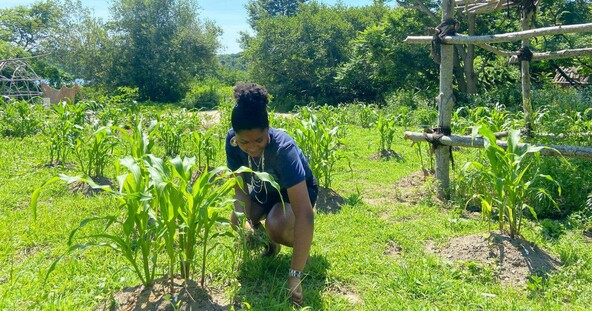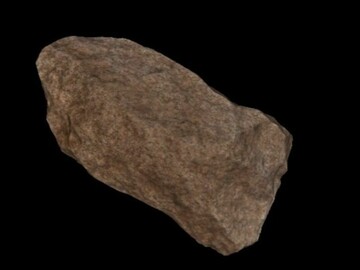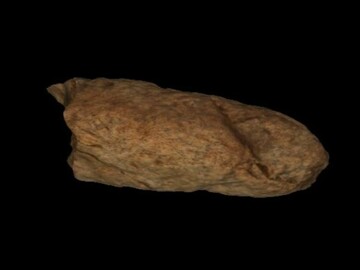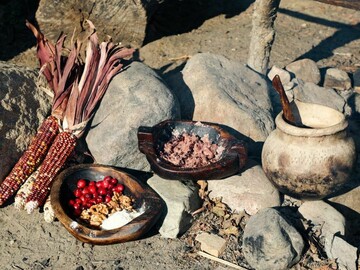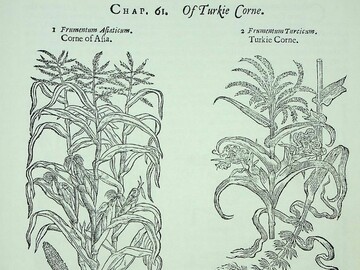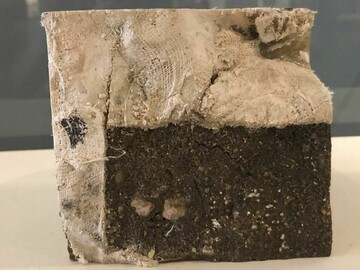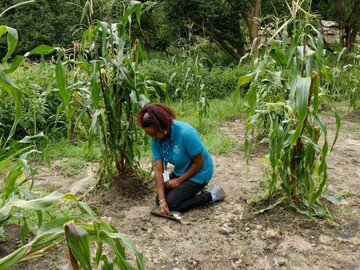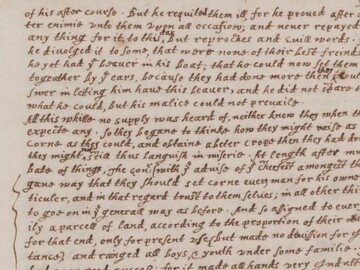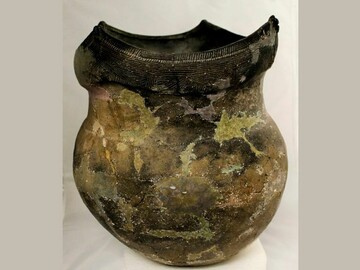Unit 3: Summary
This Unit aligns with the Cultural Creations Sort (Activity 3) in the "You are the Historian" Interactive Game.
Learning Themes:- People of the Dawn Land
- New Worlds for All: Families and Their Everyday Lives
- Communities in Collaboration and Conflict
- Manitou and Providence: New England’s Dual Spiritual Realms
This unit supports students’ exploration of corn as both a primary source and the central feature of the harvest celebrated in Fall 1621. Students will explore Tisquantum as a transatlantic historical figure, learn about the role of corn and other arable crops in the daily lives of Wampanoag and colonial English families, and use original and reproduction objects and historical images to compare and contrast agricultural practices and cultural perspectives on growing corn.
Key Ideas
- During the spring and summer of 1621, the English and Wampanoag planted corn on either side of Town Brook in New Plymouth/Patuxet.
- Tisquantum - also known as Squanto - directed the English in how to plant corn and fertilize the soil using herring (called “shad” by the English). Although the English don’t mention it in their sources, it is likely that Wampanoag women, who were responsible for the planting, helped. The English planted twenty acres of Native corn and six acres of barley and peas in 1621. Not all the crops thrived. The peas withered, and the barley did not grow as well as the Indian corn.
- “Corn” had a different meaning for the Wampanoag at Patuxet and colonial English families. For a Wampanoag family, weatchimim referred to flint corn (also known in English as Indian Corn) which has hard kernels set in rows on a cob and grows in a variety of colors. To the English, “corn” was a general term referring to different types of cereal crops particularly wheat, rye, barley, peas, and oats. The English used terms such as “turkey wheat,” “flint corn,” or “Indian corn” to refer to the weatchimim they first planted in the spring of 1621.
- Wampanoag women tended large gardens with 1-3 acres of corn, beans, and squash. Children often played and worked in the gardens alongside their mothers, sisters, aunts, grandmothers, and cousins. Men grew tobacco for special ceremonial uses, but they did not work in the gardens.
- In England, men oversaw the planting and harvesting of their family’s cereal grains and other market crops, though it seems likely the entire family may have been called to help during particularly busy seasons. Women oversaw the planting and tending of kitchen gardens that included root vegetables, salad greens, and herbs for seasoning and medicinal purposes. Children often helped in the garden.
- Throughout time, harvests have been a matter of survival. A bad harvest might bring hardship such as supply shortages, and a good harvest was a time for gratitude and celebration.
Learning Goals
In this unit, students will:
- Explore the role Tisquantum played in the development of agriculture in Plymouth.
- Learn about the essential role of corn and other cereal crops in the daily lives of Wampanoag and colonial English families leading up to the 1621 harvest celebration.
- Use objects and historical images to compare and contrast colonial English and Wampanoag cultural practices and perspectives about growing corn.
- Evaluate evidence and make reasoned judgements to sort objects by cultural origin;
- Use data to answer questions and solve problems
Essential Questions
- Who is Tisquantum and what role did he play in the development of agriculture in Plymouth?
- In the early 1600s, who was responsible for growing corn in Plymouth and Patuxet?
- How did the English colonists adapt their agricultural practices to life in Patuxet?
- What role did corn play in daily life for English and Wampanoag women and children? For English women, how were these roles different from those they had back in England?
- What technologies did Wampanoag and English people use to grow, harvest, and prepare corn?
- Why was a good harvest important for colonial and Wampanoag communities? What might happen to the community if a harvest failed? If it was successful?
Suggested Activities
Grades K-5
- Write a story, play, or graphic novel to tell a story about planting, tending, harvesting, and processing corn in 1621. What do you think Plymouth/Patuxet looked, smelled, and sounded like?
- Keep a food journal for one week. Compare what you ate with the Wampanoag and colonial English diets in the 1600s. How are their diets the same or different to yours today? Choose one food you have in common and do some research to learn more about its history.
- Work with the students to make nasaump in your classroom using only the 17th-century description and the artifacts in this unit. Do you have all the information you need? What questions do you have? Invite students to create their own variations using local, seasonal fruits
- Grinding corn was hard work! Challenge your students to see who can grind the most flour using a simple mortar and pestle available at most craft and home goods or kitchen stores.
- Draw and label a diagram of the grist mill. Label the simple machines working in the mill. How does each simple machine contribute to the process of turning corn kernels into meal?
- Compare the mortars and pestles to the water-powered mill. Reflect on what it would feel like to do this work every day and how building the mill changed daily life in Plymouth Colony?
- Explore the Wampanoag tradition of “companion planting” as an environmentally sustainable horticultural practice. What plants are involved and how do they biologically support each other?
- Plant a companion garden using corn, beans, and squash. You can do this in a school garden, in a container garden, or in pots on the window sill. Keep a record of the plants’ growth.
- Students do research to explore the role of mills in our food systems today. How and where is grain grown and ground today? How has milling technology changed since the 1600s? How has it stayed the same?
Grades 6-12
- Imagine you are planning an episode about Wampanoag food for a cooking tv show. How would you include 3-5 artifacts and the nasaump recipe in your episode? Write a script and shoot a teaser video for the episode.
- Listen to this podcast episode about mills in the 17th century. How would you determine the impact the building of a mill had on daily life for men and women in Plymouth Colony? What about Patuxet?
- Explore how corn cultivation has changed over time, particularly in the Americas. Compare the benefits and challenges of traditional Wampanoag “companion planting” with other agricultural practices common in the US today.
- Evaluate the “common course of labor” and its impact on the success of Plymouth Colony. Where was it used, and where wasn’t it in Plymouth Colony in 1623? Do you think a common course of labor would work in American communities today? For what types of work? Why or why not?
Additional resources
Curriculum Alignments
K.T4
What kinds of work do women, men, and children do?
1.T4
How do the resources of an area affect its industries and jobs?
2.T2
How do people adapt to or change their environment?
2.T3
What are the different reasons people choose to settle in a community?
3.T2
How did Native Peoples live in New England before Europeans arrived?
3.T4
What were the challenges for women and men in the early years in
Plymouth?3.T5
How did the interactions of Native Peoples, Europeans, and enslaved and free Africans shape the development of Massachusetts?
Spatial Patterns and Movements
- D2.Geo.7.K-2., D2.Geo.8.K-2., D2.Geo.9.K-2., D2.Geo.7.3-5., D2.Geo.8.3-5
- D2.Geo.9.6-8.
Changing Spatial Patterns
D2.Geo.12.K-2., D2.Geo.11.3-5
Place, Regions, and Culture
- D2.Geo.5.K-2., D2.Geo.6.K-2., D2.Geo.4.3-5., D2.Geo.5.3-5.,D2.Geo.6.3-5.
- D2.Geo.4.6-8., D2.Geo.4.9-12., D2.Geo.5.6-8., D2.Geo.5.9-12., D2.Geo.6.6-8., D2.Geo.6.9-12
Change, Continuity, and Context
- D2.His.1.K-2., D2.His.2.K-2., D2.His.3.K-2., D2.His.1.3-5., D2.His.2.3-5., D2.His.3.3-5
- D2.His.1.6-8., D2.His.2.6-8., D2.His.3.6-8., D2.His.1.9-12., D2.His.2.9-12., D2.His.3.9-12.
Perspectives
- D2.His.4.K-2., D2.His.6.K-2., D2.His.4.3-5., D2.His.5.3-5., D2.His.6.3-5.
- D2.His.4.6-8., D2.His.5.6-8., D2.His.4.9-12., D2.His.5.9-12., D2.His.6.9-12., D2.His.7.9-12., D2.His.8.9-12
Historical Sources and Evidence
- D2.His.9.K-2., D2.His.10.K-2., D2.His.12.K-2., D2.His.9.3-5., D2.His.10.3-5., D2.His.12.3-5., D2.His.13.3-5.
- D2.His.10.6-8., D2.His.12.6-8., D2.His.13.6-8., D2.His.12.9-12.,
Causation and Argumentation
- D2.His.16.3-5.
- D2.His.14.6-8., D2.His.15.6-8., D2.His.16.6-8., D2.His.14.9-12., D2.His.15.9-12., D2.His.16.9-12.
CCSS.ELA-LITERACY.RH.6-8.1
Cite specific textual evidence to support analysis of primary and secondary sources.
CCSS.ELA-LITERACY.RH.6-8.3
Identify key steps in a text's description of a process related to history/social studies (e.g., how a bill becomes law, how interest rates are raised or lowered).
CCSS.ELA-LITERACY.RH.6-8.4
Determine the meaning of words and phrases as they are used in a text, including vocabulary specific to domains related to history/social studies.
CCSS.ELA-LITERACY.RH.6-8.5
Describe how a text presents information (e.g., sequentially, comparatively, causally)
CCSS.ELA-LITERACY.RH.6-8.6
Identify aspects of a text that reveal an author's point of view or purpose (e.g., loaded language, inclusion or avoidance of particular facts).
CCSS.ELA-LITERACY.RH.6-8.7
Integrate visual information (e.g., in charts, graphs, photographs, videos, or maps) with other information in print and digital texts.
CCSS.ELA-LITERACY.RH.6-8.9
Analyze the relationship between a primary and secondary source on the same topic.
CCSS.ELA-LITERACY.RH.9-10.3
Analyze in detail a series of events described in a text; determine whether earlier events caused later ones or simply preceded them.
CCSS.ELA-LITERACY.RH.9-10.4
Determine the meaning of words and phrases as they are used in a text, including vocabulary describing political, social, or economic aspects of history/social science.
CCSS.ELA-LITERACY.RH.9-10.6
Compare the point of view of two or more authors for how they treat the same or similar topics, including which details they include and emphasize in their respective accounts.
CCSS.ELA-LITERACY.RH.9-10.7
Integrate quantitative or technical analysis (e.g., charts, research data) with qualitative analysis in print or digital text.
CCSS.ELA-LITERACY.RH.9-10.9
Compare and contrast treatments of the same topic in several primary and secondary sources.
CCSS.ELA-LITERACY.RH.11-12.2
Determine the central ideas or information of a primary or secondary source; provide an accurate summary that makes clear the relationships among the key details and ideas.
CCSS.ELA-LITERACY.RH.11-12.3
Evaluate various explanations for actions or events and determine which explanation best accords with textual evidence, acknowledging where the text leaves matters uncertain.
CCSS.ELA-LITERACY.RH.11-12.6
Evaluate authors' differing points of view on the same historical event or issue by assessing the authors' claims, reasoning, and evidence.
CCSS.ELA-LITERACY.RH.11-12.7
Integrate and evaluate multiple sources of information presented in diverse formats and media (e.g., visually, quantitatively, as well as in words) in order to address a question or solve a problem.
CCSS.ELA-LITERACY.RH.11-12.9
Integrate information from diverse sources, both primary and secondary, into a coherent understanding of an idea or event, noting discrepancies among sources.
CCSS.ELA-LITERACY.RI.6.1
Cite textual evidence to support analysis of what the text says explicitly as well as inferences drawn from the text.
CCSS.ELA-LITERACY.RI.6.3
Analyze in detail how a key individual, event, or idea is introduced, illustrated, and elaborated in a text (e.g., through examples or anecdotes).
CCSS.ELA-LITERACY.RI.6.7
Integrate information presented in different media or formats (e.g., visually, quantitatively) as well as in words to develop a coherent understanding of a topic or issue.
CCSS.ELA-LITERACY.RI.6.9
Compare and contrast one author's presentation of events with that of another (e.g., a memoir written by and a biography on the same person).
CCSS.ELA-LITERACY.RI.7.3
Analyze the interactions between individuals, events, and ideas in a text (e.g., how ideas influence individuals or events, or how individuals influence ideas or events).
CCSS.ELA-LITERACY.RI.7.6
Determine an author's point of view or purpose in a text and analyze how the author distinguishes his or her position from that of others.
CCSS.ELA-LITERACY.RI.7.9
Analyze how two or more authors writing about the same topic shape their presentations of key information by emphasizing different evidence or advancing different interpretations of facts
CCSS.ELA-LITERACY.RI.8.3
Analyze how a text makes connections among and distinctions between individuals, ideas, or events (e.g., through comparisons, analogies, or categories).
CCSS.ELA-LITERACY.RI.8.6
Determine an author's point of view or purpose in a text and analyze how the author acknowledges and responds to conflicting evidence or viewpoints.
CCSS.ELA-LITERACY.RI.8.9
Analyze a case in which two or more texts provide conflicting information on the same topic and identify where the texts disagree on matters of fact or interpretation.
CCSS.ELA-LITERACY.RI.9-10.3
Analyze how the author unfolds an analysis or series of ideas or events, including the order in which the points are made, how they are introduced and developed, and the connections that are drawn between them.
CCSS.ELA-LITERACY.RI.9-10.6
Determine an author's point of view or purpose in a text and analyze how an author uses rhetoric to advance that point of view or purpose.
CCSS.ELA-LITERACY.RI.9-10.9
Analyze seminal U.S. documents of historical and literary significance (e.g., Washington's Farewell Address, the Gettysburg Address, Roosevelt's Four Freedoms speech, King's "Letter from Birmingham Jail"), including how they address related themes and concepts.
CCSS.ELA-LITERACY.RI.11-12.3
Analyze a complex set of ideas or sequence of events and explain how specific individuals, ideas, or events interact and develop over the course of the text.
CCSS.ELA-LITERACY.RI.11-12.7
Integrate and evaluate multiple sources of information presented in different media or formats (e.g., visually, quantitatively) as well as in words in order to address a question or solve a problem.
CCSS.ELA-LITERACY.RI.11-12.9
Analyze seventeenth-, eighteenth-, and nineteenth-century foundational U.S. documents of historical and literary significance (including The Declaration of Independence, the Preamble to the Constitution, the Bill of Rights, and Lincoln's Second Inaugural Address) for their themes, purposes, and rhetorical features.
CCSS.ELA-LITERACY.L.6.6
Acquire and use accurately grade-appropriate general academic and domain-specific words and phrases; gather vocabulary knowledge when considering a word or phrase important to comprehension or expression.
CCSS.ELA-LITERACY.L.8.4.C
Consult general and specialized reference materials (e.g., dictionaries, glossaries, thesauruses), both print and digital, to find the pronunciation of a word or determine or clarify its precise meaning or its part of speech.
CCSS.ELA-LITERACY.L.8.6
Acquire and use accurately grade-appropriate general academic and domain-specific words and phrases; gather vocabulary knowledge when considering a word or phrase important to comprehension or expression.
CCSS.ELA-LITERACY.L.9-10.4.C
Consult general and specialized reference materials (e.g., dictionaries, glossaries, thesauruses), both print and digital, to find the pronunciation of a word or determine or clarify its precise meaning, its part of speech, or its etymology.
CCSS.ELA-LITERACY.L.9-10.6
Acquire and use accurately general academic and domain-specific words and phrases, sufficient for reading, writing, speaking, and listening at the college and career readiness level; demonstrate independence in gathering vocabulary knowledge when considering a word or phrase important to comprehension or expression.
